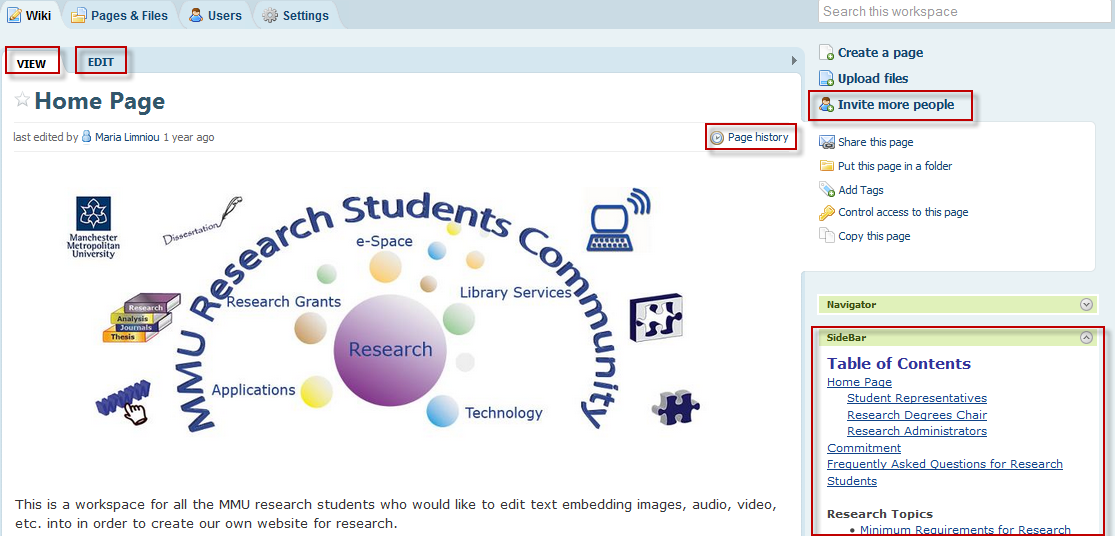Wikis are a websites that allow people to work together as a group on a collaborative task. For example, wikis are used by a group of students or a whole class to devise a report or a project that needs to be regularly edited by each member until a group/class are satisfied with the final version. Each student can easily edit, add to and delete content. Wikis keep a record of all previous changes that have been done and when the changes were made. The group of students/each student can revert the content to previous versions, if needed. The wiki pages are displayed as “static” to readers/editors, despite their work-in-progress nature (for example, there is no a reverse chronological order as in the case of blogs). Another wiki feature is that each wiki page comes with a “comment” area allowing online discussions below it. Also, wikis can be public being editable by anyone or private being editable by only a specific group of people invited by the wiki owner.
Teachers may set up a wiki through Virtual Learning Environments (VLEs) which is a quite straightforward process or they may use the freely available wiki platforms such as PBWorks and Wikispaces, after signing up with that service.
In the case of VLE’s wikis, both teachers and students can click on “Edit Wiki Content” and “Create Wiki Page” to edit the content of a page or to create a new wiki page. A Word processor allows users to add text, images, hyperlinks, etc. and make the changes to the document under a quite simple interface, as they can do in a regular Word document or other digital writing environment. Once users are satisfied with what they have done, they can simply save the page. The difference between the two interface (for teachers and students) are the options
- “Participation and Grading”, where teachers provide feedback and a grade to their students; and
- “My Contribution”, where students can view their teachers’ feedback and their score for their participation in the wiki activity.
The benefit of using wikis inside a VLE is that students are already enrolled and have access to it, while in the case of using a free wiki platform the owners need to add users by their email addresses. Additionally, teachers can easily create groups and assign to each of them different wiki space.
In the case of using a free wiki platform, the wiki owners have all the administration rights. They can choose the levels of access for the invited participants giving permissions to act as administrators, editors, writers or readers for the whole wiki or a page-level only.
No matter what kind of wiki platform teachers decide to develop the wiki activities, this particular learning activity is based on socio-cultural constructivism, as collaboration is at the heart of teaching and learning approach. Students should be encouraged to work together with their peers, exchange content and comments, and develop teamwork skills. However, at the same time learners are encouraged to be engaged through the analysis, synthesis, evaluation and creativity process. Three main types of wiki activities and/or combination of them can be integrated into courses.
- administration wiki activity, where teachers use wikis for study resources, topics covered in the course syllabus, assignments, etc. The purpose for students is to contribute to various topics/pages or ask questions via discussions dealing day-to-day management issues;
- class-wiki activity, where teachers create a wiki space around a specific topic and students contribute as a group or as a whole class; and
- individual student wiki activity, where students use wikis as an e-portfolio spaces and are linked to a class wiki space.
By using wikis in their teaching and learning process, teachers can assess students contribution by providing grades and feedback to an individual student or the same grades and feedback to a group of students. The assessment criteria in all the cases should be clearly presented to students making sure that criteria follow learning outcomes and curriculum/learning objectives. The assessment criteria should cover areas such as content (comprehension, development of content, use of data, etc.), pages (structure and organisation, writing quality, frequency and quality of pages, etc.) and appearance (use of enhancements and widgets, quality of teamwork, distribution of task, etc.). By designing wikis through a VLE platform, teachers can adapt a rubric to the wiki activity allowing students to check the assessment criteria before, during and after the assignment preparation.

Wikis in Education by Maria Limniou is licensed under a Creative Commons Attribution-NonCommercial-ShareAlike 3.0 Unported License.


